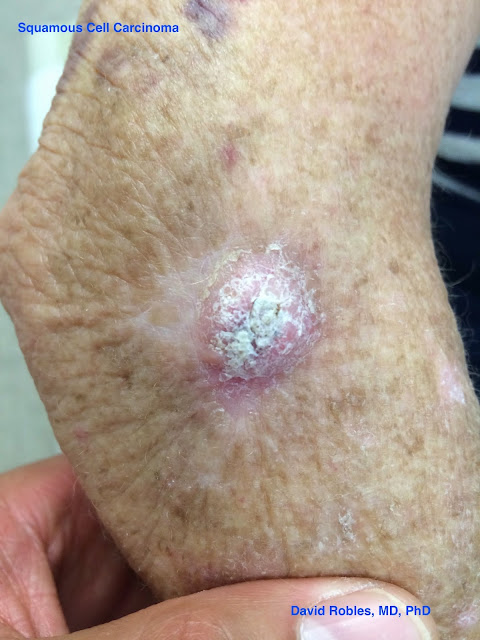The three major forms of skin cancer include,
squamous cell carcinoma, basal cell carcinoma and melanoma. Squamous cell
carcinoma (SCC) is the second most common skin cancer (basal cell carcinoma is the
most common). It is more common in older people with fair skin and light hair. Squamous cell carcinoma arises within sun-damaged skin, most frequently on the head and neck, arms, hands and legs.
SCC may arise from untreated pre-skin cancerous lesions called actinic keratoses. Actinic keratoses are easily treated and should not be ignored and allowed to convert to skin cancer. SCC is usually not life threatening, but may be aggressive in some cases. SCC on the lips and ears tend to behave more aggressively. If left untreated, it can become very destructive and cause serious complications and even metastasize. Squamous cell carcinoma is primarily caused by the cumulative ultraviolet (UV) exposure, which adds up throughout one’s lifetime. Just like putting pennies in a piggy bank everyday, UV-induced damage adds up over a person’s lifetime. Even just 15 minutes of sun exposure a day can add up to 7,756 hours of UV exposure in a person living to be 85 years of age. Tanning bed use also increases the risk of squamous cell carcinoma.
SCC may arise from untreated pre-skin cancerous lesions called actinic keratoses. Actinic keratoses are easily treated and should not be ignored and allowed to convert to skin cancer. SCC is usually not life threatening, but may be aggressive in some cases. SCC on the lips and ears tend to behave more aggressively. If left untreated, it can become very destructive and cause serious complications and even metastasize. Squamous cell carcinoma is primarily caused by the cumulative ultraviolet (UV) exposure, which adds up throughout one’s lifetime. Just like putting pennies in a piggy bank everyday, UV-induced damage adds up over a person’s lifetime. Even just 15 minutes of sun exposure a day can add up to 7,756 hours of UV exposure in a person living to be 85 years of age. Tanning bed use also increases the risk of squamous cell carcinoma.
The growth of these cancers may vary from slow
growing to rapidly growing lesions, which grow in a matter of weeks. The diagnosis is made with a skin biopsy. The lesion is numbed with a lidocaine injection, and the growth is
removed and sent to a laboratory for review under a microscope by a pathologist.
With early diagnosis and treatment, squamous cell carcinoma is highly curable. They may be treated by
routine excision or a specialty surgery called Mohs. Early or non-invasive
lesions may be treated with a “scrape” technique called electrodessication and
curettage or even with topical chemotherapy.







Comments
Post a Comment